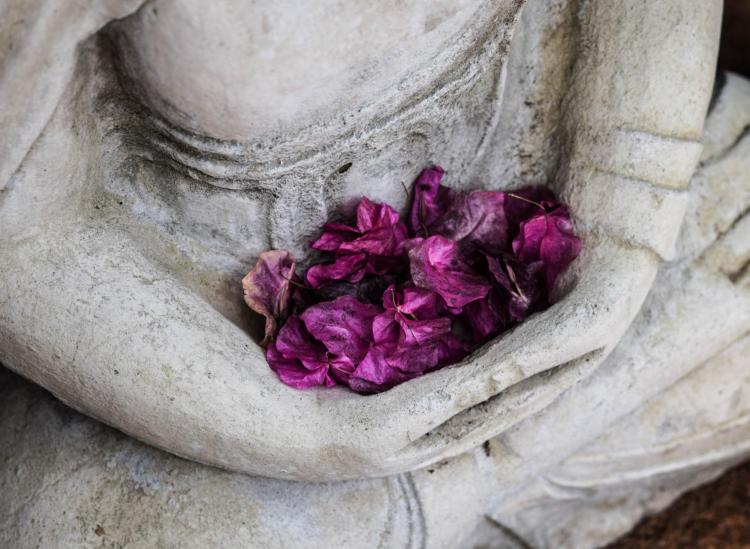How To Pick The Right Kind Of Meditation For You

Unsplash/Chris Ensey
Meditation has officially hit the mainstream. Fewer and fewer people are feeling turned off by any potential religious undertones or so chill that they simply don’t need help relaxing. We’re all hella stressed, and we’re all willing to do whatever it takes to feel better — especially if that thing is considered healthy, too.
The biggest barrier to entry with meditation today is its homogenous look. Brick-and-mortar studios are painted all white, decorated minimally with a few green plants in the corners and full of folks sitting on little pillows with their eyes closed. And you can pretty much forget it when it comes to social media — from mala beads to crystal magic, meditation is depicted in very particular ways that don’t properly represent the variety the practice has to offer.
So if you’ve considered meditation before but thought, “Meh, this doesn’t look like it’s for me,” look again. Below are nine different meditation styles that can help you live a balanced life if you give them a chance.
1. Breath Awareness Meditation
Anapanasati, or breath awareness meditation, is an ideal place for many beginners to start. It’s the type of meditation that Buddha originally taught and practiced, focusing on how a present connection to the breath can help you develop not only a happy and concentrated mind, but also a sense of personal insight. The main idea is simple: Actively observe what it feels like to inhale and exhale, and as you do, the mind will naturally calm and find a sense of freedom.

Unsplash/Eli DeFaria
2. Loving-Kindness Meditation
This form of meditation is ideal if you’re wanting to tap into your natural sense of empathy, achieve a stronger sense of gratitude and learn to love yourself. The practice says that all living things are deserving of love, and you must first love and accept yourself in order to be able to extend love and acceptance to others. It uses a combination of visualization and phrase repetition techniques to help you ultimately soften your mind and heart to the world around you.
3. Transcendental Meditation
One of the most widely practiced forms of meditation, transcendental meditation is the perfect choice if you’re someone who appreciates routine and structure in your life. The technique is practiced for 20 minutes twice each day while sitting in a comfortable position with your eyes closed. As you repeat a simple mantra, the hope is that you can avoid distracting thoughts and access a space of pure consciousness, which brings you a sense of stillness, rest, stability and order.

Unsplash/Hans Vivek
4. Focused Attention Meditation
This meditation style works well if you tend to think very literally about the aspects of your life. In order to quiet the chatter of the mind, focused attention meditation has you (as the name suggests) focus your full attention on a single thing. That thing could be a physical object like a flame, a mantra like other meditation forms use or even the idea of the Buddha himself. Because all you’re doing is thinking of this singular thing and allowing yourself to breathe, all other distractions (and stressors) can fall away.
5. Mantra Meditation
Sensing a theme yet? Yes, mantras can be a very helpful tool in meditation, and this form employs them in a specific way. By repeating or chanting a single word, phrase or syllable audibly, you give your mind an anchor to which it can grab a hold of at any time. You use it for as long as you like, making the practice what you need it to be for you. Mantra meditation is especially helpful if you’re coping with an unwelcome emotional situation, insomnia or a deeply rooted fear.

Unsplash/Bady QB
6. Movement Meditation
If the thought of sitting still for minutes on end for something other than sleep makes your skin crawl, then give movement meditation a try. Just trade that meditation pillow for an activity that feels very familiar to you, be it jogging, walking through nature or practicing yoga. And while you do those things, rather than zoning out, use your breath to keep you connected to your movement, bringing your mind into the present moment.
7. Visualization Meditation
If you’ve always considered yourself to be a visual learner, lean into that tendency with your meditation style. Visualization meditation asks you to conjure a particular image in your mind’s eye and hold it there, allowing it to be the focus of your meditation practice. The idea is that if you create an image that is calming and centering for your mind, your body will follow suit and feel the sensations that mental picture evokes. You can choose a still image or a moving scene — whatever helps you reach the place you’re trying to access.

Unsplash/Jared Rice
8. Zen Meditation
Zen meditation is another helpful starting point for newcomers feeling overwhelmed by all of their choices. With roots in Zen Buddhism, this practice is all about proper posture and consistent practice, for that’s the only true way to train your mind. Once you’re in a comfortable but alert seated position, take deep, counted breaths and let the emotions, thoughts or feelings that arise within you be acknowledged without judgment and simply fall to the side as you continue to breathe.
9. Mindfulness Meditation
Last but not least, mindful meditation is another common practice today because it’s so accessible for everyone. All you have to do is find a comfortable seated position, take note of your breath and let your mind go. When you notice that your thoughts have wandered away from you, just return to your intention. This practice is all about observation without feeling compelled to react, which is a lesson that could be easily translated to the rest of life.
RELATED
Stressed AF But Not Into Meditation? This New Wellness Trend Is For You
If Meditation Isn’t Your Thing, Try Watching Nature Documentaries Instead
This Ancient Martial Art Could Be The Key To Boosting Your Overall Well-Being











